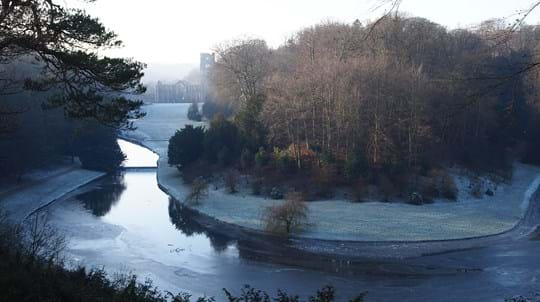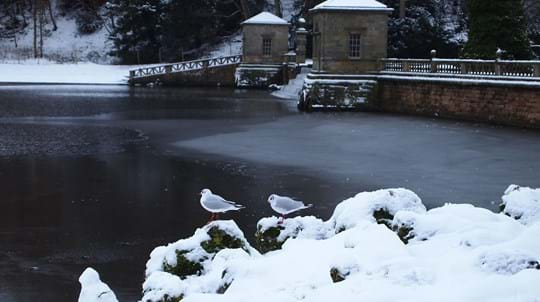
Hackfall
Grewelthorpe

Woodland Trust wood
48.06 ha (118.76 acres)
SE236771
Explorer 298
OS Landranger 99
This ancient woodland has been restored to its former glory and boasts original features such as grottos and glades, rustic temples and waterfalls, as well as carpets of bluebell in spring and an impressive number of woodland birds.
In 2011, Hackfall was awarded a highly coveted 2011 European Union Prize for Cultural Heritage at the Europa Nostra Awards. It won in the conservation category for the restoration of the 18th century planned landscape.
Features
- Parking at site
- Parking nearby
- Public access
- Spring flowers
- Grassland
- Broadleaved woodland
How to get to Hackfall
Situated on the edge of the beautiful Yorkshire Dales within the Nidderdale Area of Outstanding Natural Beauty, Hackfall covers 47 hectares (nearly 120 acres) of ancient semi-natural woodland within a steep, rocky gorge of the River Ure.
It is 29km (18 miles) from Harrogate, 9.7km (six miles) north-west of Ripon, 4.8km (three miles) from Masham, and on the doorstep of the village of Grewelthorpe.
Hackfall is 9.7km (six miles) north-west of Ripon and north of Grewelthorpe. From Ripon, take the A6108 north-west to Masham. From Masham, turn left out of the market place near the community centre onto Church Street. Follow the road around a left-hand bend onto Park Street. Head out of Masham on Thorpe Road and over the River Burn bridge towards Grewelthorpe for approximately 1.6km (one mile).
The nearest train station is Leyburn, 22.5km (14 miles) away, while Thirsk station is 30.5km (19 miles) away.
Visit National Rail for more information.
Bus service number 159 between Ripon and Leyburn usually runs three times per day, stopping at Grewelthorpe.
Visit Traveline for more information.
Facilities and access
There is no wheelchair access to Hackfall because of the terrain, and there are steep paths.
There are four separate entrances. The two most popular are at the top of the site. These have steep slopes or steps. To access them, start from the Grewelthorpe to Masham minor road. The southerly one can be reached by following the road from Grewelthorpe for around 200 metres towards Masham and then turning right into Hackfall. This entrance has no barriers and the path follows a shallow slope, with some steps.
The northerly entrance is approximately halfway between Grewelthorpe and Masham and is along a public right of way next to a car park. The entrance from the car park is through a kissing gate. Direct access from the road is over a step-over stile. The path heads down a track and through a kissing gate into fields.
Once in the field, turn right, to a over a step-over stile. Alternatively, continue down the fields on the public path to enter the lower part of the wood through a kissing gate.
Some paths are compacted earth and can be very muddy, particularly in wet conditions.
The free Woodland Trust car park is on your left (HG4 3BS), approximately 0.85km (0.5 miles) before Grewelthorpe Village.
There is also alternative parking available in Masham.
There are no toilets on site. The nearest public toilets are in Masham, around 3km (two miles) away, behind the Bruce Arms and Old Police Station. However, there are toilet facilities in the Grewelthorpe village hall.
Wildlife and habitats
Animals
Hackfall is a designated a Site of Special Scientific Interest (SSSI) because of the large number of birds, plants and invertebrates that live or feed here.
Look out for kingfisher, dipper, grey wagtail and common sandpiper around the waterlogged river margins and tributary streams around the River Ure. There have even been reports of osprey in the woods.
Trees, plants and fungi
Much of the wood was clear-felled in the 1930s. Not much replanting happened after, so many of the trees have regenerated naturally. This allowed some more aggressive species like sycamore to dominate.
However, there is a still a good mix of tree species and Hackfall is a diverse woodland.
Habitats
Hackfall is north-facing and very steep in places. Its plant communities have been affected by the underlying geology and the localised flushing from the calcium-rich water which arises from numerous springs. These springs, the river and the sheltered location produce a very humid microclimate at the bottom of the wood.
History of Hackfall
Hackfall appears today to be a natural wood, a ‘beautiful wilderness’. In fact, it is very much a landscape moulded by people. Famous landscaper John Aislabie bought Hackfall in 1731. His son William set about transforming Hackfall into an ornamental landscape that would appear completely natural to the visitor.
The design was developed around views of both the built features and the natural features. Several scenes even featured on a dinner service, known as the Green Frog service, which was commissioned by Catherine the Great from Wedgwood and Bentley for one of her palaces.
Hackfall then went through a long period of decline, and in 1932 was sold to a timber merchant who clear felled it. A period of general neglect followed, resulting in the gradual decay of the buildings; while flooding eroded the water features.

Credit: David Rodway / WTML
Inspiring artists
Many artists found inspiration at Hackfall; from romantic landscape painters such as Turner and Devis to modern-day Masham artist Ian Scott Massie. Much of what we know about Hackfall today comes from their diary notes, sketches and completed works. The area also became famous as a tourist destination during the European Tours taken by wealthy young men in the 18th century.

Credit: Mark Sunderland / WTML
Hackfall's buildings
The buildings and built features dotted around Hackfall give us a glimpse of how the site was designed for enjoyment. It's full of highlights of natural vistas with spaces of beauty and reflection.
Find out more about Hackfall's buildings.
Threats and conservation
In 1987, the woods came under threat from commercial development. In response, the Hackfall Trust was formed to safeguard the wood. In 1989, we acquired the site on a 999 year-lease with grant aid from various bodies including the Hackfall Trust and English Heritage. That same year, Hackfall was classified as a Site of Special Scientific Interest (SSSI) and a site of ancient semi-natural woodland.
We set about restoring the site with the Hackfall Trust. Hackfall is now a Grade 1 listed garden, with the Hackfall Trust responsible for the on-site management, while working closely with us.
In 2007, a major restoration project was funded by the Heritage Lottery Fund. This enabled the restoration and preservation of the buildings; the dredging and restoration of water features; further improvement of the footpaths and opening up of the vistas.

A lasting legacy
This wood is just one of many to have been protected by gifts in wills, securing it for generations to come. Your legacy gift could also make a real difference to woods, trees and wildlife.
Learn what your gift could meanThings to do at Hackfall
Walking
There are plenty of routes to take in the beauty of Hackfall. We'd recommend about two hours to visit. There are a few set walks you can take, from 30 minutes to 2-3 hours long.
For a longer ramble try the 7-8 mile Masham to Hackfall walk.











































































